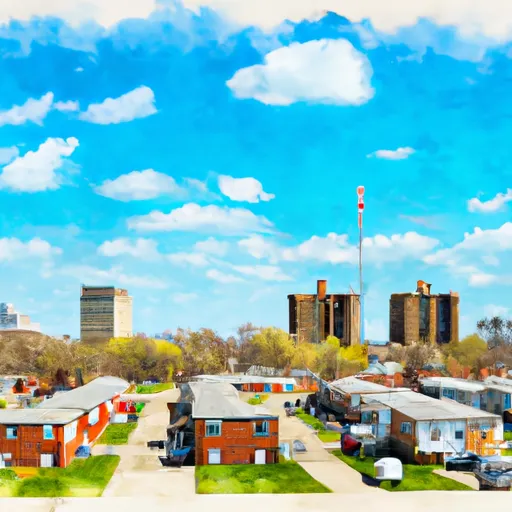-
 Snoflo Premium
Snoflo Premium
Get unlimited access to all our content
With no Ad interruptions! - Start Your Free Trial Login with existing account
Whiting
Eden Index
Climate
8.2
•
Recreation
4.2
•
Community
2.0
•
Safeguard
5.2/10

Whiting, Indiana is a city located in Lake County, in the northwest part of the state. The climate in Whiting is classified as continental, with four distinct seasons. Summers are warm and humid, with average temperatures ranging from the mid-70s to the mid-80s Fahrenheit. Winters are cold, with average temperatures ranging from the mid-20s to the mid-30s Fahrenheit.
Hydrology constituents in Whiting are primarily influenced by the nearby Lake Michigan. The lake provides a source of water for various recreational activities, as well as a habitat for diverse aquatic life. Additionally, several rivers and creeks flow through or near Whiting, including the Little Calumet River and the Calumet River, which offer opportunities for fishing, boating, and other water-based activities.
Whiting boasts numerous outdoor recreation opportunities. The city is home to Whihala Beach, a popular spot for swimming, sunbathing, and picnicking. The Whiting Park and Whiting Lakefront Park offer green spaces, walking trails, and playgrounds for families to enjoy. For nature enthusiasts, the nearby Hoosier Prairie State Nature Preserve provides opportunities for hiking and bird-watching. Overall, Whiting, Indiana offers a variety of outdoor activities for residents and visitors to enjoy throughout the year.
What is the Eden Index?
The Snoflo Eden Index serves as a comprehensive rating system for regions, evaluating their desirability through a holistic assessment of climate health, outdoor recreation opportunities, and natural disaster risk, acknowledging the profound impact of these factors on livability and well-being.
Climate Health Indicator (CHI): 8.2
Whiting receives approximately
959mm of rain per year,
with humidity levels near 80%
and air temperatures averaging around
11°C.
Whiting has a plant hardyness factor of
6, meaning
plants and agriculture in this region thrive during a short period during spring and early summer. Most
plants will die off during the colder winter months.
By considering the ideal temperature range, reliable water supplies, clean air, and stable seasonal rain or snowpacks, the Climate Health Indicator (CHI) underscores the significance of a healthy climate as the foundation for quality living.
A healthy climate is paramount for ensuring a high quality of life and livability in a region, fostering both physical well-being and environmental harmony. This can be characterized by ideal temperatures, reliable access to water supplies, clean air, and consistent seasonal rain or snowpacks.
Weather Forecast
Streamflow Conditions
Southwestern Lake Michigan
Area Rivers
Southwestern Lake Michigan
Snowpack Depths
Southwestern Lake Michigan
Reservoir Storage Capacity
Southwestern Lake Michigan
Groundwater Levels
Recreational Opportunity Index (ROI): 4.2
The Recreational Opportunity Index (ROI) recognizes the value of outdoor recreational options, such as parks, hiking trails, camping sites, and fishing spots, while acknowledging that climate plays a pivotal role in ensuring the comfort and consistency of these experiences.
Access to outdoor recreational opportunities, encompassing activities such as parks, hiking, camping, and fishing, is crucial for overall well-being, and the climate plays a pivotal role in enabling and enhancing these experiences, ensuring that individuals can engage in nature-based activities comfortably and consistently.
Camping Areas
| Campground | Campsites | Reservations | Toilets | Showers | Elevation |
|---|---|---|---|---|---|
| Kimmell City Park | 10 | 415 ft | |||
| Lincoln Trail | None | 412 ft | |||
| Lynnville Park | 70 | 465 ft | |||
| Hawthorne County Park | None | 568 ft | |||
| Forest Glen County Preserve | 42 | 669 ft | |||
| Sullivan County Park | 450 | 520 ft | |||
| Ouabache Trails County Park | 45 | 446 ft | |||
| Fowler County Park | None | 581 ft | |||
| Paris City Park | None | 668 ft | |||
| Cayuga Park Campground | 29 | 509 ft |
Nearby Ski Areas
Catastrophe Safeguard Index (CSI):
The Catastrophe Safeguard Index (CSI) recognizes that natural disaster risk, encompassing floods, fires, hurricanes, and tornadoes, can drastically affect safety and the overall appeal of an area.
The level of natural disaster risk in a region significantly affects safety and the overall livability, with climate change amplifying these risks by potentially increasing the frequency and intensity of events like floods, fires, hurricanes, and tornadoes, thereby posing substantial challenges to community resilience and well-being.
Community Resilience Indicator (CRI): 2.0
The Community Resilience Indicator (CRI) recognizes that education, healthcare, and socioeconomics are crucial to the well-being of a region. The CRI acknowledges the profound impact of these elements on residents' overall quality of life. By evaluating educational resources, healthcare accessibility, and economic inclusivity, the index captures the essential aspects that contribute to a thriving community, fostering resident satisfaction, equity, and social cohesion.

